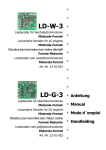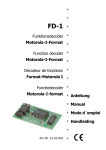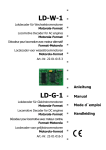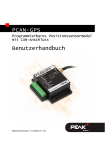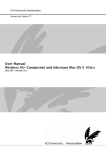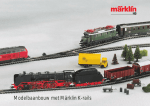Download Motorola LD-W-1 Specifications
Transcript
n LD-W-1 n Lokdecoder für Wechselstrommotoren Motorola-Format n Locomotive Decoder for AC engines Motorola-Format n Décodeur pour locomotive avec moteur alternatif Format-Motorola n Locdecoder voor wisselstroommotoren Motorola-format n Art.-Nr. 22-01-015 C 21 27 00 n n n n LD-G-1 n Anleitung Lokdecoder für Gleichstrommotoren Motorola-Format n Manual Locomotive Decoder for DC engines Motorola-Format n Mode d´emploi Décodeur pour locomotive avec moteur continu Format-Motorola n Handleiding Locdecoder voor gelijkstroommotoren Motorola-format n Art.-Nr. 22-01-016 C 21 27 96 n © 08/2001 Tams Elektronik GmbH Alle Rechte, insbesondere das Recht der Vervielfältigung und Verbreitung sowie der Übersetzung vorbehalten. Vervielfältigungen und Reproduktionen in jeglicher Form bedürfen der schriftlichen Genehmigung durch die Tams Elektronik GmbH. Technische Änderungen vorbehalten. © 08/2001 Tams Elektronik GmbH All rights reserved. No part of this publication may be reproduced or transmitted in any form or by any means, electronic or mechanical, including photocopying, without prior permission in writing from Tams Elektronik GmbH. Subject to technical modification. © 08/2001 Tams Elektronik GmbH Tout droits réservés, en particulier les droits de reproduction et de diffusion ainsi que le traduction. Toute duplication ou reproduction sous quelque forme que ce soit nécessite l´accord écrit de la societé Tams Elektronik GmbH. Sous réserve de modifications techniques. © 08/2001 Tams Elektronik GmbH Alle rechten voorbehouden. Niets uit deze publicatie mag worden vermenigvuldigd opgeslagen of openbaar gemaakt, zonder voorafgaande schriftelijke toestemming van Tams Elektronik GmbH. Technische wijzigingen voorbehouden. n n n n Deutsch n English 20 n Français 35 n Nederlands 51 n n n n n n n n n n n n n 3 English LD-G-1 / LD-W-1 Table of contents How to use this manual 21 Intended use 21 Safety instructions 22 EMC declaration 24 Information: Motorola I and Motorola II format 24 Operation overview 25 Checking the package contents 26 Technical specifications 26 Required tools and consumables 26 Safe and correct soldering 27 Performing a visual check 27 Mounting the locomotive decoder 28 Setting the locomotive decoder 31 Operation 32 FAQ 32 Manufacturer's note 33 Certification 34 Conditional warranty 34 Diagram: Setting the locomotive address 68 Circuit Diagram LD-G-1 (Fig. 1) Circuit Diagram LD-W-1 (Fig. 2) I II Connections 1: front LD-G-1 and LD-W-1 (Fig. 3a and 3b) III Connections 2: rear LD-G-1 (Fig. 4) and LD-W-1 (Fig. 5) IV (Pages I to IV in the centre of this handbook are removeable) Page 20 LD-G-1 / LD-W-1 English How to use this manual If you have no specialist technical training, this manual gives step-bystep instructions for safe and correct fitting of the module, and operation. Before you start, we advise you to read the whole manual, particularly the chapter on safety instructions and the FAQ chapter. You will then know where to take care and how to prevent mistakes which take a lot of effort to correct. Keep this manual safely so that you can solve problems in the future. If you pass the kit on to another person, please pass on the manual with it. Intended use ! Caution: Integrated circuits are very sensitive to static electricity. Do not touch components without first discharging yourself. Touching a radiator or other grounded metal part will discharge you. The module can be used according to the specifications of this manual. It is designed for the mounting in a model railway locomotive with d.c. motor (LD-G-1) resp. a.c. motor (LD-W-1). It evaluates the Motorola format data sent by the digital central unit to its address. The decoder controls the vehicle performance (velocity, direction of travel, acceleration), switches the lighting and four further optional functions. The module is not suitable for children under the age of 14. Reading, understanding and following the instructions in this manual are mandatory for the user. Any other use of the kit is inappropriate and invalidates any guarantees. Page 21 English LD-G-1 / LD-W-1 Safety instructions Mechanical hazards Cut wires can have sharp ends and can cause serious injuries. Watch out for sharp edges when you pick up the PCB. Visibly damaged parts can cause unpredictable danger. Do not use damaged parts: recycle and replace them with new ones. Electrical hazards § Do not touch powered, live components. § Do not touch conducting components which are live due to malfunction. Avoid short circuits. Do not connect the circuit to a higher voltage than designed. Impermissibly high humidity. Condensation building up can cause serious injury due to electrical shock. Take the following precautions to prevent this danger: § Never perform wiring on a powered module. § Only use low power for this module as described in this manual and only use certified transformers. § Connect transformers and soldering stations only in approved mains sockets installed by an authorised electrician. § Observe cable diameter requirements. § Assembling the kit should only be done in closed, clean, dry rooms. Beware of humidity. § If the humidity in the room is too high, please do not start working until after a minimum of 2 hours of acclimatisation. § Use only original spare parts if you have to repair the kit or the ready-built module. § § § § Page 22 LD-G-1 / LD-W-1 English Fire risk Touching flammable material with a hot soldering iron can cause lifethreatening fire, burns and toxic smoke. Connect your soldering iron or soldering station only when actually needed. Use the correct soldering iron or station and never leave a hot soldering iron or station unattended. Thermal danger A hot soldering iron or liquid solder accidentally touching your skin can cause skin burns. As a precaution: § § § § use a heat-resistant mat during soldering, always put the hot soldering iron in the soldering iron stand, point the soldering iron tip carefully when soldering, and remove liquid solder with a thick wet rag or wet sponge. Dangerous environments A working area that is too small or cramped is unsuitable and can cause accidents, fires and injury. Prevent this by working in a clean, dry room with enough freedom of movement. Other dangers Children can cause any of the accidents mentioned above because they are inattentive and not responsible enough. Children under the age of 14 should not be allowed to work with this kit or the ready-built module. Little children can swallow small components with sharp edges. Life threatening! Do not allow components to reach small children. In schools, training centres, clubs and workshops, assembly must be supervised by qualified personnel. In industrial institutions, health and safety regulations applying to electronic work must be adhered to. Page 23 English LD-G-1 / LD-W-1 EMC declaration This product is developed in accordance with the European standards EN 55014 and EN 50082-1, tested corresponding to the EC - directive 89/336/EWG (EMVG of 09/11/1992, electromagnetic tolerance) and meets legal requirements. To guarantee the electromagnetic tolerance you must take the following precautions: § Connect the transformer only to an approved mains socket installed by an authorised electrician. § Make no changes to the original parts and accurately follow the instructions, circuit diagram and PCB layout included with this manual. § Use only original spare parts if you have to repair the kit or the ready-built module. Information: Motorola I and Motorola II format The digital driving data is differently encoded and transmitted in the (old) Motorola I format and the (new) Motorola II format. The locomotive decoder is designed to evaluate data in Motorola II format. This limits its use in Motorola I format. Since data of the auxiliary functions F1 to F4 sent in Motorola I Format cannot be evaluated by the locomotive decoder, it is not possible to switch these functions on or off when using Motorola I format. Unlike the Motorola II format, no absolute direction data is sent in Motorola I format, but a single driving signal reverses the direction of travel. This has the following consequences: 1. If the change direction command is not recognized by the locomotive, it continues in the original direction. 2. If the decoder is switched off for some time and the direction data is not saved, the locomotive continues in its favourite direction when it is switched on again. Page 24 LD-G-1 / LD-W-1 English Operation overview The decoder is designed for operation in Motorola I or II format and can be adjusted to one of 255 adresses. It evaluates the digital data sent by the central unit to its address and transmitts it to the locomotive. Function speed level and direction of motion The speed level set at the central unit and the change-direction command are transmitted to the locomotive by the decoder. At a direction change the existing direction of travel is not saved, so the locomotive continues in Motorola I format in its preferred direction after the decoder has been off for some time. Acceleration and brake delay Three variants of acceleration and brake delay are available: fast, medium and slow. By attaching solder bridges one of the three variants can be fixed. Function lighting The lighting can be switched on and off according to the direction of travel from the central unit via the function "function". In addition, another optional accessory (e.g. cab lighting, noise module) can be switched on and off according to the direction of travel. Auxiliary functions in Motorola II format The auxiliary functions F1 to F4 can be switched from the central unit. They are available to control optional accessories (e.g. smoke generator, cab lighting, noise module). Restrictions in Motorola I format The auxiliary functions F1 to F4 are not available in Motorola I format. It is possible to control one accessory via the function "function" according to the direction of travel. Page 25 English LD-G-1 / LD-W-1 Checking the package contents Check the contents of the package for completeness: § 1 module § 1 manual Technical specifications Data format Supply voltage Current consumption (without connected loads) Max. current for motor Max. current per function output Max. total current Protected to Ambient temperature in use Ambient temperature in storage Comparative humidity allowed Dimensions Weight Motorola I and II 12-22 Volt digital voltage ca. 10 mA 1.000 mA 500 mA 1.500 mA IP 00 0 - + 60° C -10 - + 80° C max. 85 % ca. 25 x 17 x 8 mm ca. 5 g Required tools and consumables Make sure you have the following tools, equipment and materials ready for use: § § § § § § a heat-resistant mat a soldering iron stand with tip-cleaning sponge a small side cutter and wire stripper an electronic soldering iron (max. 30 Watt) with a fine tip tin solder (0,5 mm. diameter) wire (diameter: > 0,08 mm² for all connections) Page 26 LD-G-1 / LD-W-1 English Safe and correct soldering ! Caution: Incorrect soldering can cause fires (through excessive heat). Avoid this danger by reading the chapter Safety instructions again and following the directions given. If you have had training in soldering you can skip this chapter. § When soldering electronic circuits never use soldering-water or soldering grease. They contain acids that can corrode components and copper tracks. § Only use tin solder SN 60 Pb (i.e. 60 % tin, 40 % lead) with rosinbased flux. § Solder fast: long soldering can destroy components and copper tracks, and damages through plated holes. § Use a small soldering iron with max. 30 Watt. Keep the soldering tip clean so the heat of the soldering iron is applied to the solder point effectively. § Apply the soldering tip to the soldering spot in such a way that the part and the soldering spot are heated at the same time. Simultaneously add solder (not too much). As soon as the solder becomes liquid take it away. Hold the soldering tip at the spot for a few seconds so that the tin solder finds its way, then remove the soldering iron. § Do not move the component for about 5 seconds after soldering. A glossy and perfect soldering spot should remain. § To make a good soldering joint you must use a clean and unoxidised soldering tip. Clean the soldering tip with a damp piece of cloth, a damp sponge or a piece of silicon cloth. Performing a visual check Damaged materials can cause injury. Parts damaged during transit can also be dangerous.Check the module for damage, missing parts or poor soldering. If you find damage, return the module for exchange. Page 27 English LD-G-1 / LD-W-1 Mounting the locomotive decoder Open the locomotive housing. Locate the position for the decoder. Disconnect the motor from the rail current collector respectively the change-over switch from the motor and rails if you have a locomotive with electronic change-over switch. ! Caution: The interference suppression devices mounted to the motor or the connecting wire must not be removed! Motor and interference suppression devices are one unit. If even one part is removed, it can cause extreme interference! Connecting the LD-G-1 Follow the connections diagrams (fig. 4)! Solder the connections to the rails at points X1 and X2 (rear of the locomotive decoder) and the connections to the motor at the points X11 and X12 (rear of the locomotive decoder). The connection to the rails is optional, but you must observe polarity when connecting the motor. Tip: In three rail systems, connect the centre conductor to X2. The locomotive response to control data improves, compared with connection to X1. Connecting the LD-W-1 Follow the connections diagrams (fig. 5)! Solder the connections to the rails at points X1 and X2 (rear of the locomotive decoder) and the connections to the motor at the points X11, X12 and X19 (rear of the locomotive decoder). ! Caution: The connections to the rails and motor must be made as shown in the diagram "connections"! Otherwise the locomotive decoder will not respond to the control data sent by the central unit. Page 28 LD-G-1 / LD-W-1 English Connecting the lighting and other accessories Follow the connections diagrams (fig. 3a and 3b)! Disconnect any existing diodes in the leads to the lamps. Connect the lamps for forward motion to X4 and the lamps for reverse to point X5 (front of the locomotive decoder). If the lamps are already connected with one side to locomotive ground, you must solder in a diode between the decoder and the lamp (see fig. 3a) or you must connect the second side of the lamps according to fig. 3b to the return conductor (point X3 on the front of the decoder). Connect other accessories (e.g. smoke generator, cab lighting), which are switched by the functions F1 to F4, to the points X7 to X10 (front of the decoder). You can connect the second side of the accessories either to the return conductor (point X3) or to locomotive ground. If connecting the accessory to locomotive ground you must solder in a diode. ! Caution: The return conductor for all functions (point X3) must under no circumstances be connected to locomotive ground. Possible short circuit! The locomotive decoder will be damaged in operation. Tip: If the second side of the lamps is connected to locomotive ground the lamps often flicker in operation. You can avoid the flickering of the lamps if you connect the second side to the return conductor (point X3) instead of locomotive ground. ! Caution: If you connect the loads to the return conductor for all functions (point X3), the load must be insulated. The loads must not make contact with metal parts of the locomotive. Possible short circuit! The locomotive decoder will be damaged in operation. Connecting the LEDs The function outputs of the locomotive decoder switch against decoder ground. For that reason you must connect the cathode (-) of the LED to the output of the relevant function. Page 29 English ! LD-G-1 / LD-W-1 Caution: If you use light-emitting diodes (LEDs) you must always operate them via a series resistor. LEDs are available in many different models. There are LEDs with 2-5 mA, but also LEDs with 15-30 mA power consumption. The series resistor limits the current flow of the LED and will need to be calculated for each model. Ask for the max current rating when buying your LEDs. You can connect several LEDs in parallel to each output. In this case every LED must have a series resistor of its own. If you connect several LEDs to one output in series, only one series resistor is needed. The number of LEDs connected in series to one output depends on the digital voltage. You can determine the number of the LEDs that can be connected in series to one output from the following formula: (number of LEDs + 2) x 1,5 < digital voltage Fixing the locomotive decoder After completing all connections fix the locomotive decoder with doublesided adhesive tape, for example. Using an NEM 652 interface connector Contact 1 2 3 4 5 6 7 8 Page 30 Connection Motor connection 1 Lighting back (-) Not used or F1 Power supply left Motor connection 2 Lighting front (-) Common conductor for all functions (+) Power supply right Colour of cable orange yellow green black grey white blue Connecting points X11 X5 X7 X1 X12 X4 X3 red X2 LD-G-1 / LD-W-1 English Some locomotives already have an NEM 652 interface connector mounted. Using a convenient connecting plug you save disconnecting the connections and you do not need to solder at the locomotive. The list shows how to connect the contacts of the interface connector to the connecting points of the locomotive decoder. Setting the locomotive decoder Setting the acceleration and brake delay The locomotive decoder can be set to one of three different delays: fast, medium or slow. The setting is made by mounting solder bridges to X17 (on the front of the decoder, beneath the IC U1). The assignment is as follows: Fast delay No solder bridge Medium delay Solder bridge between two optional solder pads Slow delay Solder bridge across all the solder pads or Setting the locomotive address The locomotive decoder can be set to one of 255 addresses. The setting is made by mounting solder bridges to X13 - X17 (on the front of the decoder, left of the IC U1) resp. X18 on the front of the decoder, right of the IC U1). The assignment is shown in the list on page 68. The solder pads are numbered from the left side of the PCB as follows: 1 2 3 The solder pad "4" is identical with connecting point X18. If for one address two connections to solder pad 4 are given, two connections to point X18 must be made. Page 31 English ! LD-G-1 / LD-W-1 Caution: Use a soldering iron with a small tapered point and max. 30 Watt to make the solder bridges. Take special care to avoid short circuits. If necessary, check the solder bridges with a magnifiying glass to make sure that the solder bridges are closed correctly and solder has not short-circuited adjacent components or connections. Operation Emergency stop during active acceleration and brake delay An emergency stop during acceleration and brake delay can be performed from the central unit by changing the direction of travel. Improvement of the driving characteristics Locomotives with especially high current consumption or track sections with bad contacts (e.g. some types of points) may give an unsatisfactory performance after the mounting of the locomotive decoder. You can improve the locomotive performance by soldering a capacitor 220 µF / > 25 V in parallel to the capacitor C2 (rear of the locomotive decoder, see fig. 4 or 5). The settings cannot be saved by the decoder and are lost after a power supply interruption of a certain length. When the interruption is only short, the capacitor C1 maintains the voltage and the settings are kept. You can lengthen this period of time by soldering a capacitor 47 µF / > 6,3 V in parallel to the capacitor C1 (rear of the locomotive decoder, see fig. 4 or 5). FAQ § Parts are getting too hot and/or start to smoke. ! Disconnect the system from the mains immediately! Possible cause: one or more connections are soldered incorrectly. à Check the connections. Page 32 LD-G-1 / LD-W-1 English Possible cause: The connection of the motor is connected to locomotive ground. à Disconnect the connection from locomotive ground. § The locomotive lighting does not correspond to its direction of travel. Possible cause: The forward and backward light connections have been exchanged. à Check the connections. Possible cause: The connections of the motor to the points X11 and X12 have been exchanged. à Exchange the connections. § A lamp flickers (this is not a defect). Possible cause: The lamp is connected with one side to locomotive ground. à If you do not want the lamp to flicker, disconnect it from locomotive ground, insulate it and connect it to the return conductor (point X3). § The locomotive does not run. Possible cause: The locomotive address is not set correctly. à Check the solder bridges (if necessary with a magnifiying glass). Possible cause (locomotive with LD-W-1): The connections to the rails (points X1 and X2) have been exchanged. à Exchange the connections. If you cannot find the problem, please return the decoder for repair (address on the cover page). Manufacturer's note According to DIN VDE 0869, the person who builds this kit or brings the circuit into operation is the manufacturer of the product. If he sells the product to another person he is responsible for passing on all the relevant papers. Domestic appliances assembled from a kit are deemed industrial products and must comply with health and safety regulations. Page 33 English LD-G-1 / LD-W-1 Certification This product conforms with the EC- directive 89/336/EWG on electromagnetic radiation and is therefore CE certified. Conditional warranty This product is guaranteed for two years. The warranty includes free repair if the problem is due to material failure or incorrect assembly of the module by us. We guarantee the quality of the components. Other claims are excluded. By law, we are not responsible for damages or secondary damages in connection with this product. We retain the right to repair, make improvements, supply spare parts or return the purchase price. The following invalidate the warranty: § using an unsuitable soldering iron, solder containing liquid acids or similar, § if damage is caused by not following the instructions in this manual or the circuit diagram, § if the circuit has been altered and repair attempts have failed, § if arbitrary changes in the circuit are made, § if parts are stored incorrectly and if the wires to the switches, the § § § § § § § power resistors, etc. are made incorrectly, if the copper tracks or soldering points are damaged, if parts are placed incorrectly or the circuit is connected incorrectly, if damage occurs due to an overload of the circuit, if the wrong power or current is connected, if damaged by other persons, if damaged by the wrong use or abuse of the circuit, if parts are damaged due to static because they were touched before a discharge is performed. Page 34 LD-G-1 / LD-W-1 Einstellung der Adresse / Adjusting the address Réglage de l’adresse / Instellen van het adres Beispiel: Einstellung der Adresse "107" Example: Adjusting the address "107" Exemple: Réglage de l´adresse "107" Voorbeeld: Instellen van adres "107" Adresse Lötfeld - Soldering field Address Plots d´une rangé Adresse Soldeerpunten Adres X14 X13 X16 X15 1 2-3 2-4 2-3 2-4 2 2-3 2-4 2-4 2-4 3 2-4 2-3 2-4 2-3 4 2-3 2-3 2-3 2-3 5 2-3 2-3 2-4 2-3 6 2-4 2-4 2-4 2-3 7 2-3 2-4 2-3 2-3 8 2-3 2-4 2-4 2-3 9 1-2 2-4 1-2 2-4 10 -2-4 -2-4 11 -2-4 1-2 2-4 12 1-2 2-3 1-2 2-3 13 -2-3 -2-3 14 -2-3 1-2 2-3 15 1-2 2-4 1-2 2-3 16 -2-4 -2-3 17 -2-4 1-2 2-3 18 1-2 2-4 2-4 2-4 19 -2-4 2-3 2-4 20 -2-4 2-4 2-4 Seite - Page - Page - Pagina 68 Adresse Lötfeld - Soldering field Address Plots d´une rangé Adresse Soldeerpunten Adres X14 X13 X16 X15 21 1-2 2-3 2-4 2-3 22 -2-3 2-3 2-3 23 -2-3 2-4 2-3 24 1-2 2-4 2-4 2-3 25 -2-4 2-3 2-3 26 -2-4 2-4 2-3 27 2-4 1-2 2-4 1-2 28 2-3 1-2 2-3 1-2 29 2-3 1-2 2-4 1-2 30 2-4 -2-4 -31 2-3 -2-3 -32 2-3 -2-4 -33 2-4 1-2 2-4 -34 2-3 1-2 2-3 -35 2-3 1-2 2-4 -36 1-2 1-2 1-2 1-2 37 -1-2 -1-2 38 -1-2 1-2 1-2 39 1-2 -1-2 -40 ----- LD-G-1 / LD-W-1 Adresse Lötfeld - Soldering field Address Plots d´une rangé Adresse Soldeerpunten Adres X14 X13 X16 X15 41 --1-2 -42 1-2 1-2 1-2 -43 -1-2 --44 -1-2 1-2 -45 1-2 1-2 2-4 1-2 46 -1-2 2-3 1-2 47 -1-2 2-4 1-2 48 1-2 -2-4 -49 --2-3 -50 --2-4 -51 1-2 1-2 2-4 -52 -1-2 2-3 -53 -1-2 2-4 -54 2-4 2-4 2-4 1-2 55 2-3 2-4 2-3 1-2 56 2-3 2-4 2-4 1-2 57 2-4 2-3 2-4 -58 2-3 2-3 2-3 -59 2-3 2-3 2-4 -60 2-4 2-4 2-4 -61 2-3 2-4 2-3 -62 2-3 2-4 2-4 -63 1-2 2-4 1-2 1-2 64 -2-4 -1-2 65 -2-4 1-2 1-2 66 1-2 2-3 1-2 -67 -2-3 --68 -2-3 1-2 -69 1-2 2-4 1-2 -70 -2-4 --71 -2-4 1-2 -72 1-2 2-4 2-4 1-2 73 -2-4 2-3 1-2 74 -2-4 2-4 1-2 75 1-2 2-3 2-4 -76 -2-3 2-3 -- Adresse Lötfeld - Soldering field Address Plots d´une rangé Adresse Soldeerpunten Adres X14 X13 X16 X15 77 -2-3 2-4 -78 1-2 2-4 2-4 -79 -2-4 2-3 -80 2-4 2-4 2-4 2-4 81 2-4 2-4 2-3 2-4 82 2-4 2-4 2-3 2-3 83 2-3 -1-2 1-2 84 2-4 2-3 2-3 2-3 85 1-2 2-4 2-3 2-4 86 1-2 2-4 2-3 2-3 87 1-2 2-3 2-3 2-4 88 1-2 2-3 2-3 2-3 89 2-4 2-4 -2-4 90 2-4 2-4 -2-3 91 2-4 2-3 -2-4 92 2-4 2-3 -2-3 93 1-2 2-4 -2-4 94 1-2 2-4 -2-3 95 1-2 2-3 -2-4 96 1-2 2-3 -2-3 97 2-4 2-4 2-3 1-2 98 2-4 2-4 2-3 -99 2-4 2-3 2-3 1-2 100 2-4 2-3 2-3 -101 1-2 2-4 2-3 1-2 102 1-2 2-4 2-3 -103 1-2 2-3 2-3 1-2 104 1-2 2-3 2-3 -105 2-4 2-4 -1-2 106 2-4 2-4 --107 2-4 2-3 -1-2 108 2-4 2-3 --109 1-2 2-4 -1-2 110 1-2 2-4 --111 1-2 2-3 -1-2 112 1-2 2-3 --Seite - Page - Page - Pagina 69 LD-G-1 / LD-W-1 Adresse Lötfeld - Soldering field Address Plots d´une rangé Adresse Soldeerpunten Adres X14 X13 X16 X15 113 2-4 1-2 2-3 2-4 114 2-4 1-2 2-3 2-3 115 2-4 -2-3 2-4 116 2-4 -2-3 2-3 117 1-2 1-2 2-3 2-4 118 1-2 1-2 2-3 2-3 119 1-2 -2-3 2-4 120 1-2 -2-3 2-3 121 2-4 1-2 -2-4 122 2-4 1-2 -2-3 123 --1-2 1-2 124 2-4 --2-3 125 1-2 1-2 -2-4 126 1-2 1-2 -2-3 127 1-2 --2-4 128 1-2 --2-3 129 2-4 1-2 2-3 1-2 130 2-4 1-2 2-3 -131 2-4 -2-3 1-2 132 2-4 -2-3 -133 1-2 1-2 2-3 1-2 134 1-2 1-2 2-3 -135 1-2 -2-3 1-2 136 1-2 -2-3 -137 2-4 1-2 -1-2 138 2-4 1-2 --139 2-4 --1-2 140 2-4 ---141 1-2 1-2 -1-2 142 1-2 1-2 --143 1-2 --1-2 144 1-2 ---145 2-4 2-3 2-4 2-4 146 1-2 2-3 2-4 2-4 147 2-4 2-3 1-2 2-4 148 1-2 2-3 1-2 2-4 Seite - Page - Page - Pagina 70 Adresse Lötfeld - Soldering field Address Plots d´une rangé Adresse Soldeerpunten Adres X14 X13 X16 X15 149 2-4 2-3 2-4 1-2 150 1-2 2-3 2-4 1-2 151 2-4 2-3 1-2 1-2 152 1-2 2-3 1-2 1-2 153 2-4 -2-4 2-4 154 1-2 -2-4 2-4 155 2-4 -1-2 2-4 156 1-2 -1-2 2-4 157 2-4 -2-4 1-2 158 1-2 -2-4 1-2 159 2-4 -1-2 1-2 160 1-2 -1-2 1-2 161 2-3 2-3 2-3 2-4 162 -2-3 2-3 2-4 163 2-3 2-3 -2-4 164 -2-3 -2-4 165 2-3 2-3 2-3 1-2 166 -2-3 2-3 1-2 167 2-3 2-3 -1-2 168 -2-3 -1-2 169 2-3 -2-3 2-4 170 --2-3 2-4 171 2-3 --2-4 172 ---2-4 173 2-3 -2-3 1-2 174 --2-3 1-2 175 2-3 --1-2 176 ---1-2 177 2-3 2-3 2-4 2-4 178 -2-3 2-4 2-4 179 2-3 2-3 1-2 2-4 180 -2-3 1-2 2-4 181 2-3 2-3 2-4 1-2 182 -2-3 2-4 1-2 183 2-3 2-3 1-2 1-2 184 -2-3 1-2 1-2 LD-G-1 / LD-W-1 Adresse Lötfeld - Soldering field Address Plots d´une rangé Adresse Soldeerpunten Adres X14 X13 X16 X15 185 2-3 -2-4 2-4 186 --2-4 2-4 187 2-3 -1-2 2-4 188 --1-2 2-4 189 2-3 -2-4 1-2 190 --2-4 1-2 191 2-4 2-3 2-3 2-4 192 2-4 --2-4 193 2-4 2-4 1-2 2-4 194 2-4 2-4 1-2 1-2 195 2-4 1-2 1-2 2-4 196 2-4 1-2 1-2 1-2 197 2-3 2-4 -2-4 198 2-3 2-4 -1-2 199 2-3 1-2 -2-4 200 2-3 1-2 -1-2 201 2-3 2-4 1-2 2-4 202 2-3 2-4 1-2 1-2 203 2-3 1-2 1-2 2-4 204 2-3 1-2 1-2 1-2 205 2-4 2-3 1-2 2-3 206 2-4 2-3 1-2 -207 2-4 -1-2 2-3 208 2-4 1-2 1-2 -209 2-3 2-3 -2-3 210 2-3 2-3 --211 2-3 --2-3 212 2-3 ---213 2-3 2-3 1-2 2-3 214 2-3 2-3 1-2 -215 2-3 -1-2 2-3 216 2-3 -1-2 -217 2-4 2-4 1-2 2-3 218 2-4 2-4 1-2 -219 2-4 1-2 1-2 2-3 220 2-4 1-2 1-2 -- Adresse Lötfeld - Soldering field Address Plots d´une rangé Adresse Soldeerpunten Adres X14 X13 X16 X15 221 2-3 2-4 -2-3 222 2-3 2-4 --223 2-3 1-2 -2-3 224 2-3 1-2 --225 2-3 2-4 1-2 2-3 226 2-3 2-4 1-2 -227 2-3 1-2 1-2 2-3 228 2-3 1-2 1-2 -229 2-4 1-2 2-4 2-4 230 2-3 1-2 2-3 2-4 231 2-3 1-2 2-4 2-4 232 2-4 -2-4 2-3 233 2-3 -2-3 2-3 234 2-3 -2-4 2-3 235 2-4 1-2 2-4 2-3 236 2-3 1-2 2-3 2-3 237 2-3 1-2 2-4 2-3 238 1-2 1-2 1-2 2-4 239 -1-2 -2-4 240 -1-2 1-2 2-4 241 1-2 -1-2 2-3 242 ---2-3 243 --1-2 2-3 244 1-2 1-2 1-2 2-3 245 -1-2 -2-3 246 -1-2 1-2 2-3 247 1-2 1-2 2-4 2-4 248 -1-2 2-3 2-4 249 -1-2 2-4 2-4 250 1-2 -2-4 2-3 251 --2-3 2-3 252 --2-4 2-3 253 1-2 1-2 2-4 2-3 254 -1-2 2-3 2-3 255 -1-2 2-4 2-3 Seite - Page - Page - Pagina 71 LD-G-1 LD-G-1 LD-G-1 Schaltplan Circuit diagram Schéma de principe Schakelschema n n n Fig. 1 Seite - Page - Page - Pagina I Ausgänge Outputs Sorties Uitgangen Seite - Page - Page - Pagina I LD-W-1 LD-W-1 LD-W-1 Schaltplan Circuit diagram Schéma de principe Schakelschema n n n Fig. 2 Seite - Page - Page - Pagina II Ausgänge Outputs Sorties Uitgangen Seite - Page - Page - Pagina II LD-G-1 / LD-W-1 LD-G-1 / LD-W-1 Anschlußplan 1 Connections 1 Plan de raccordement 1 Aansluit plan 1 n n n Fig. 3a / 3b Seite - Page - Page - Pagina III Seite - Page - Page - Pagina III LD-G-1 / LD-W-1 LD-G-1 / LD-W-1 Anschlußplan 2 Connections 2 Plan de raccordement 2 Aansluit plan 2 n n n Fig. 4 / 5 Seite - Page - Page - Pagina IV Seite - Page - Page - Pagina IV n n n Aktuelle Informationen und Tipps: Information and tips: Informations et conseils: Actuele informatie en tips: http://www.tams-online.de n n n n n n Garantie und Service: Warranty and service: Garantie et service: Garantie en service: n n Tams Elektronik GmbH Sievertstraße 22 D-30625 Hannover fon: 0049 (0)511 / 55 60 60 fax: 0049 (0)511 / 55 61 61 e-mail: [email protected] n n



























